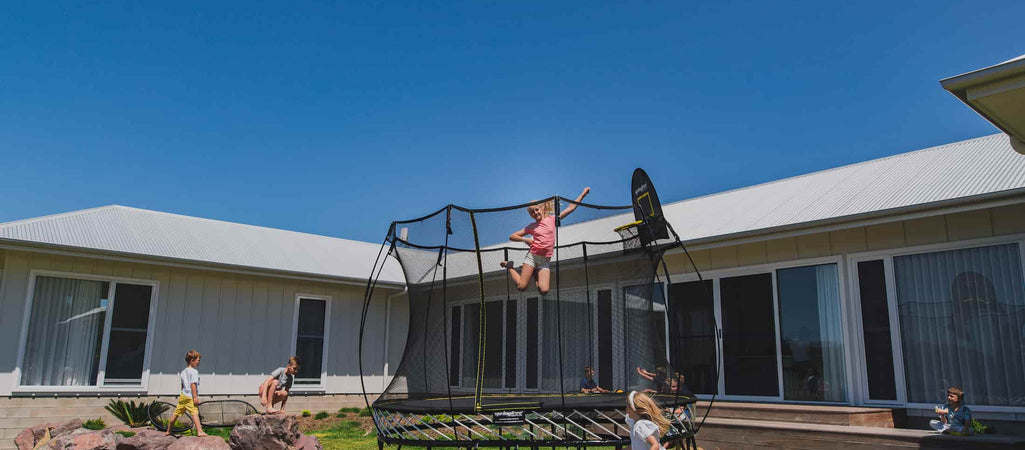A Trampoline Size Comparison You MUST See | Insights Revealed
Crack the code of trampoline sizes! Our expert guide spills industry secrets, compares two top models, and reveals essential information for a successful purchase.
min read

A true trampoline size comparison is long overdue.
Many companies don’t completely answer the question about trampoline sizes because there’s a “hidden” secret behind it.
We’re going to use our expertise at Springfree Trampoline to provide honest insights into trampoline sizes, including a full comparison of two trampoline models.
You will also learn of that little industry secret that comes back to haunt many buyers in this comprehensive Trampoline Size Guide.
Why Are Trampoline Sizes Important?
Before getting into the details, let’s touch on why the size of a trampoline is so crucial to a worthwhile purchase.
- It affects backyard space: An outdoor trampoline takes up space, and you must make sure that it fits safely in your yard.
- It affects safety: Trampolines have clearance space requirements to ensure your kids are safe when jumping!
- It affects who can use it: Trampolines have weight limits, and not adhering to them could cause injury.
- It affects jumping room: Having plenty of jumping space is paramount, especially for growing kids. (A lot more on this topic later).
- It affects the user experience: Big trampolines with plenty of space open up more opportunities for your child to play games, practice gymnastics or do tricks.
- It affects pricing: The bigger the trampoline, the more expensive it will be.
- It affects installation: Larger trampolines weigh more and might be more complicated to install.
The shape of the trampoline also plays a role in the factors above.
Rectangle and square trampolines tend to be better for athletic jumping, while round and oval trampolines are suitable for recreational jumping.
How Are Trampolines Measured?
Traditional (spring-based) trampolines are measured frame-to-frame, the dimension you commonly see when checking for a trampoline's size. Examples include 13’ x 13’ and 10’ x 17’.
There is no standard trampoline size. However, 12 ft and 14 ft trampolines are among the most purchased sizes.
Here is an example of how spring trampolines are measured, courtesy of JumpSport:

Springless trampolines are measured by their mat dimensions:

However, this doesn’t tell the whole story. We’ll explain.
What Many People Don’t Know About Trampoline Sizes
So, frame-to-frame measurements are important to note. They tell you how big the trampoline is, so you know whether it will fit in your yard (we also recommend adding 3-5 ft of clearance space around the trampoline).
Here’s the problem with just considering frame-to-frame measurements when buying a trampoline: It doesn’t account for the amount of jumping room you have!
Hence, the secret about trampoline sizes: Trampolines with springs have around 2 ft less jumping space than their listed size.
What does this mean?
Take a look at the picture below:
 Notice how the green and black padding around the trampoline takes up almost 2 ft of valuable jumping space.
Notice how the green and black padding around the trampoline takes up almost 2 ft of valuable jumping space.
This is why, when buying a replacement mat for a trampoline, you typically need to go 2 ft lower than its size. So, a 14 ft trampoline = a 12 ft trampoline mat.
Why is this a problem? Well, when you have growing kids, they are going to need more room to jump as they get older!
If you want a trampoline to last for your kids, having plenty of jumping room is ESSENTIAL. Based on our review of dozens of trampoline brands, most don’t list the jumping space for their trampolines.
Springless trampolines don’t have this issue because they use alternative materials for the bounce. This includes composite rods or bungee cords.
Notice in the picture below how jumping mat space is maximised due to the springless design. It represents its dimensions:

A Trampoline Size Comparison
Size is only one component of buying a trampoline. There are a lot of factors to look for when buying a trampoline, such as trampoline safety, quality, longevity, design, etc.
But when you’re comparing trampolines on size, jumping room SHOULD be in consideration – especially if you have growing kids.
We’ve put together a simple trampoline size comparison chart below to show the age range and prices for the common trampoline sizes. This will give you a sense of which trampoline sizes to look at:

FAQ: Comparing Trampoline Sizes
We’re going to take this last part to answer pressing questions about trampoline sizes. This will help broaden your understanding of sizing so you can make a fully informed comparison.
1. What Size of Trampoline Should I Buy?
The size of the trampoline you should buy depends on factors like available space, the number and age of users, and the intended use.
For smaller yards, an 8 to 10 ft trampoline may suffice, while larger spaces can accommodate 12 to 15 ft trampolines for more jumping room.
2. Is a 10 ft Trampoline Big Enough for 2 Kids?
A 10 ft trampoline is generally suitable for two smaller kids. But we recommend following a “One Jumper at a Time” Rule at all times. Trampoline injuries occur most when two people are jumping at the same time.
3. What Age Is a 10 ft Trampoline For?
A 10 ft trampoline is appropriate for children ages 6-12. However, if you want a trampoline to last, consider buying a bigger trampoline. Your child will grow fast!
4. Is a 12 ft Trampoline Big Enough for 2 Kids?
A 12 ft trampoline can be large enough for two kids, but we would advise only one person to use the trampoline at a time for safety.
5. Is a 10 ft or 12 ft Trampoline Better?
The choice between a 10 ft and a 12 ft trampoline depends on factors such as available space and jumping space required.
A 12 ft trampoline offers more room to jump and is suitable for larger families or those with more outdoor space, while a 10 ft trampoline is a more compact option for smaller backyards.
6. What Is a Good Size Trampoline for Adults?
A good-sized trampoline for adults is generally in the range of 12 to 15 ft, providing enough space for trampoline exercise.
Use Our Model Comparison Tool to Assess Trampoline Sizes
Step one is complete on your journey to jumping!
You now understand the importance of trampoline sizing, how trampolines are measured, the one “hidden” secret and have seen a comparison of trampoline sizes.
Step two? Compare trampolines yourself to see which one fits your goals and backyard the best.
Check out our free Model Comparison Tool and evaluate Springfree Trampoline sizes side-by-side. Here’s a preview:

Step three? Buy a Springfree Trampoline based on which size fits your family the best!

